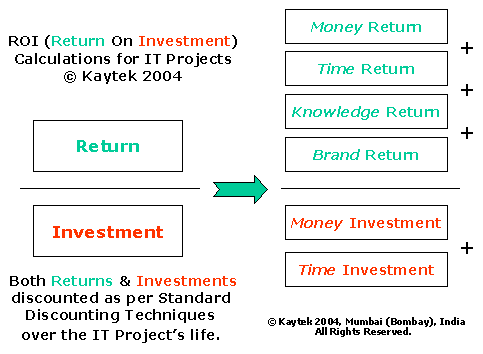 3 Step Process to calculate the ROI (Return on Investment) on IT Projects
3 Step Process to calculate the ROI (Return on Investment) on IT Projects
Firstly, it needs to be specifically mentioned that
an ERP investment is increasingly becoming a business
Decision, more than just a Technology Decision.
Hence, it is not just the CIO
or CTO that will make the
ERP Technical and Commercial Decisions. It will increasingly
be the CFO and the CEO. International Trends highlight an increasing
Percentage of IT Decisions being made by non-IT 'C' level
Executives beyond the CIO and CTO. Some of the more enlightened organizations are also involving the CKO (Chief Knowledge Officer) in their IT Decisions because IT Penetration increases the Knowledge Levels in an Organization. Many large Western organizations have appointed the COO (Chief Outsourcing Officer) because of increasing Outsourcing and Offshoring of their IT facilities and investments. At a SAP India Summit customer panel discussion a few years ago, there was no clear-cut answer as to the vexed ERP ROI question. This was shocking considering large investments made by these companies.
To throw some light on the same, our thoughts for computing an IT (including ERP) Project's ROI Estimation in a 3 Step Process are mentioned below :
 You may also read Missing SAP ROI's ?
You may also read Missing SAP ROI's ? IT Project's ROI =
Total Return / Total Investment
Incremental Returns & Investments as pertaining to People, Technology & Facilities to be expressed in Amount ($ or Rs) Terms over the IT project's estimated life (except where stated). For all the financial calculations for Returns or Investments across different time periods, appropriate Net Present Value (NPV) discounting to be done.

 Step 1 - Computing Total Investment
Step 1 - Computing Total Investment Total Investment = Money Investment + Time Investment
Money Investment = Initial One-Time Costs + Recurring Expenses
Time Investment= Time (expressed in Money Terms) spent by the Organisation's people in utilising the technologies and making processes work. All above investments to be calculated over the estimated life of the IT project.
 Step 2 - Computing Total Return
Step 2 - Computing Total Return Total Return =
Money Return + Time Return + Knowledge Return + Brand Return
Each of these four Return Components for the Organization are explained briefly below :
 Money Return -
Increased Cash-Flows due to either Increase in Revenues or Decrease in Expenses directly or indirectly attributable to the IT Project.
Money Return -
Increased Cash-Flows due to either Increase in Revenues or Decrease in Expenses directly or indirectly attributable to the IT Project. Time Return - Time saved by Organisation's People in their Personal lives expressed in Money terms after Project Implementation is completed.
This has to be estimated for whatever is shorter - person's work duration with the Organization after the IT project start or the IT project's estimated life.
Time Return - Time saved by Organisation's People in their Personal lives expressed in Money terms after Project Implementation is completed.
This has to be estimated for whatever is shorter - person's work duration with the Organization after the IT project start or the IT project's estimated life. Knowledge Return - Increase in the Knowledge of the People within the Organization due to their Expertise gained due to the Exposure to the IT Project Implementation.
Knowledge Return - Increase in the Knowledge of the People within the Organization due to their Expertise gained due to the Exposure to the IT Project Implementation.  Brand Return - Increase in Value of the Organisation's Brand - It's Image in the minds of it's critical Stake Holders (Previous, Current and Future). These are The Organization's Owners, Customers, Suppliers, Employees, Regulators, Competitors and the rest of Society.
Brand Return - Increase in Value of the Organisation's Brand - It's Image in the minds of it's critical Stake Holders (Previous, Current and Future). These are The Organization's Owners, Customers, Suppliers, Employees, Regulators, Competitors and the rest of Society. The above 4 Return Elements are also inter-related to Each Other.
 Step 3
Step 3 Computing IT Project's ROI = Total Return / Total Investment
Beyond financial returns on investment, many ERP projects help increase other forms of Non-Financial Non-Traditional Intangible Capital, many times much more than the measurable financial returns. The Definition of Return in ROI must include non-financial forms of return, to make it easier to quantify the success of IT projects.